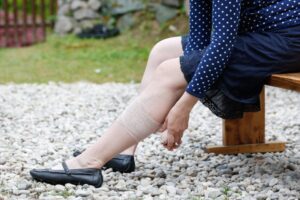Unpacking Venous Ulcers: Causes and Symptoms
When it comes to vascular health, venous ulcers are a condition that requires more awareness. Read on for a detailed look into the often-overlooked topic of venous ulcers, their causes, and the symptoms to watch out for. Understanding these aspects is important for preventing and managing this painful condition that affects many individuals. For Arizona Vein and Laser Institute clients and anyone else seeking insights into vascular health, this information can lead to timelier intervention and better outcomes.
What Are Venous Ulcers?
Venous ulcers are open wounds on the legs that are typically caused by venous insufficiency, a condition where the veins in the legs fail to circulate blood properly. These ulcers can be debilitating and are often recurrent if not managed effectively. A deeper understanding of the causes and symptoms can empower individuals to address potential issues sooner and begin the healing process.
Venous ulcers can stem from a variety of factors, such as deep vein thrombosis (DVT), superficial vein thrombosis (SVT), and phlebitis. They are often the result of malfunctioning valves within the veins, which struggle to push blood back to the heart due to pressure from gravity, leading to swollen limbs, skin changes, and eventually, ulceration.
Understanding the Causes of Venous Ulcers
Venous ulcers can be traced back to venous insufficiency, a common condition where the veins in the legs don’t return blood to the heart as they should. When this happens, blood pools in the veins, causing pressure to build. Over time, this pressure can weaken the vein walls and cause an array of symptoms, including the formation of ulcers.
Venous Insufficiency
Venous insufficiency is marked by malfunctioning valves in the veins, crucial for the one-way flow of blood back to the heart. When these valves fail, blood can leak back into the veins, leading to swelling, skin changes, and the potential for ulceration.
Risk Factors
Several factors can increase the risk of venous ulcers, such as advancing age, obesity, sedentary lifestyles, and a family history of vein disorders. These influences make a case for proactive health measures, particularly for individuals with a genetic predisposition or lifestyle circumstances that contribute to venous insufficiency.
Identifying Symptoms of Venous Ulcers
Early detection can significantly improve the prognosis of venous ulcers. Familiarizing oneself with the symptoms allows for faster intervention and a higher likelihood of successful treatment.
Navigating Pain and Swelling
One of the first signs of venous ulcers is a persistent dull pain in the legs. This is often accompanied by swelling, known as edema, due to the fluid build-up from the stagnant blood flow.
Changes in Skin Texture and Color
The skin around the affected area may undergo changes in texture, becoming thin and fragile. There may also be a noticeable pigmentation change, with the skin taking on a reddish or brown color, indicating the possible presence of an ulcer.
The Impetus of Prompt Attention
Early detection is key in diagnosing and treating venous ulcers. Recognizing these symptoms as potential precursors to ulceration can prevent the wounds from forming by enlisting the help of a professional at the first signs of trouble.
The Journey to Diagnosis
Reaching a diagnosis for venous ulcers entails a process of detection and elimination. This typically involves a comprehensive evaluation to examine the patient’s symptoms and ascertain the underlying cause of the ulceration.
Physical Examination
A physician will perform a thorough physical assessment, paying close attention to the appearance of the ulcer, the affected limb, and the patient’s medical history.
Imaging for Clarity
To confirm the presence of venous insufficiency, imaging tests such as ultrasounds may be used. These can provide detailed insights into the circulation within the veins and detect any anomalies that could be contributing to the ulceration.
Seeking Professional Expertise
Any indication of venous ulceration should prompt immediate consultation with a healthcare professional. Delaying diagnosis and treatment can lead to further complications and a decrease in the overall quality of life.
A Call to Action for Vascular Health
Venous ulcers are not merely a cosmetic issue; they are a serious health concern that can significantly impact daily life. By taking note of the causes and symptoms associated with these ulcers, individuals can seek the necessary medical attention early and prevent further complications.
Awareness
Educating yourself about venous ulcers is the first step to managing this condition. Familiarize yourself with the risk factors and maintain a healthy lifestyle to mitigate your chances of developing venous insufficiency.
Timeliness
If you or a loved one experiences any of the symptoms associated with venous ulcers, do not hesitate to seek professional help. Early intervention can prevent ulcers from forming and improve the long-term prognosis of venous insufficiency.
Take the First Step towards Healing
By shedding light on this important topic, we hope to drive awareness, encourage preventive actions, and support those currently managing the challenges of venous ulcers. Remember, when it comes to your vascular health, knowledge is power. If you are dealing with any of the symptoms or risk factors discussed, do not delay seeking medical advice. Your proactive approach to vascular health can lead to a better, more comfortable life.
Visit the Arizona Vein and Laser Institute website for more information or to schedule your consultation. With six convenient locations throughout Arizona, our expert team is readily accessible to provide the specialized care you need. Call us at 602-298-8346 or find your nearest clinic by visiting our contact page. Don’t let venous ulcers limit your lifestyle—we’re here to support you on your journey towards recovery.
